Potw1718a
A cosmic conversatio
This image from Hubble’s Wide Field Camera 3 (WFC3) shows a spiral galaxy NGC 5917, perhaps best known for its intriguing interactions with its neighbouring galaxy MCG-01-39-003 (not visible here, but located off the bottom right of the frame — as seen here).
Mass is often confused with weight, but they are very different things. Mass is the very substance of an object and is something one always has, no matter the location. If you fly to the Moon and experience low-gravity conditions, your mass has not changed at all. What has actually changed is your weight, because weight is a force caused by the gravitational attraction of another massive body. Gravity is how objects with mass “talk” to one another. People do weigh less on the Moon, but not because they have lost any body mass — the mass of the Moon is less than that of the Earth, so it exerts a smaller gravitational pull on them.
Understanding mass is vital when it comes to understanding why objects behave the way they do in space. Without mass “talking” via gravity, the planets would not orbit the Sun, and galaxies would not interact as NGC 5917 does with its neighbour. Galaxy interactions can lead to very interesting effects; the galaxies can steal mass — in form of stars, dust and gas — from one another, distort and warp one another’s shape, or trigger immense waves of new star formation. Sometimes, a galactic duo interact so strongly that they end up colliding and merging completely. Unfortunately, if NGC 5917 is destined to merge with its celestial neighbour, it will happen much too far into the future for us to enjoy the spectacle.
Credit:
ESA/Hubble & NASA
Coordinates Position (RA): 15 21 32.89 Position (Dec): -7° 22' 42.57" Field of view: 2.33 x 1.50 arcminutes Orientation: North is 32.5° left of vertical Colours & filters Band Wavelength Telescope Optical V 555 nm Hubble Space Telescope WFC3 Optical I 814 nm Hubble Space Telescope WFC3 Infrared H 1.6 μm Hubble Space Telescope WFC3 Optical I 814 nm Hubble Space Telescope WFC3 Optical Very Broad 350 nm Hubble Space Telescope WFC3.
| ESA/Hubble images, videos and web texts are released by the ESA under the Creative Commons Attribution 4.0 International license and may on a non-exclusive basis be reproduced without fee provided they are clearly and visibly credited. Detailed conditions are below; see the ESA copyright statement for full information. For images created by NASA or on the hubblesite.org website, or for ESA/Hubble images on the esahubble.org site before 2009, use the {{PD-Hubble}} tag.
Conditions:
Notes:
|
- Dieses Werk darf von dir
- verbreitet werden – vervielfältigt, verbreitet und öffentlich zugänglich gemacht werden
- neu zusammengestellt werden – abgewandelt und bearbeitet werden
- Zu den folgenden Bedingungen:
- Namensnennung – Du musst angemessene Urheber- und Rechteangaben machen, einen Link zur Lizenz beifügen und angeben, ob Änderungen vorgenommen wurden. Diese Angaben dürfen in jeder angemessenen Art und Weise gemacht werden, allerdings nicht so, dass der Eindruck entsteht, der Lizenzgeber unterstütze gerade dich oder deine Nutzung besonders.
Relevante Bilder


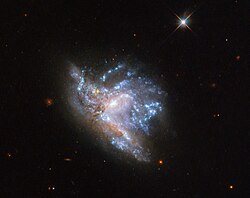



















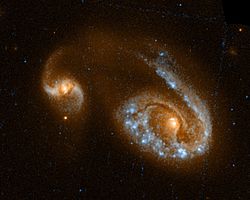
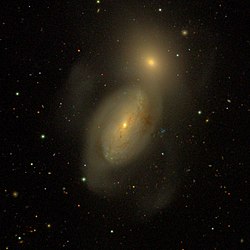




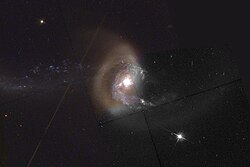


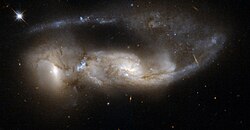





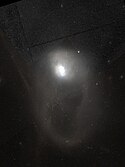




Relevante Artikel
Atlas of Peculiar GalaxiesDer Atlas of Peculiar Galaxies ist ein astronomischer Katalog. In ihm sind 338 ungewöhnliche Galaxien mit photographischen Aufnahmen aufgeführt. .. weiterlesen
NGC 5917NGC 5917 ist eine Spiralgalaxie des Typs Sb im Sternbild Waage. Sie ist rund 85 Millionen Lichtjahre von der Milchstraße entfernt. Gemeinsam mit PGC 54817 bildet sie das Galaxienpaar Arp 254. Halton Arp gliederte seinen Katalog ungewöhnlicher Galaxien nach rein morphologischen Kriterien in Gruppen. Diese Galaxie gehört zu der Klasse Galaxien mit Anzeichen für eine Aufspaltung. .. weiterlesen


